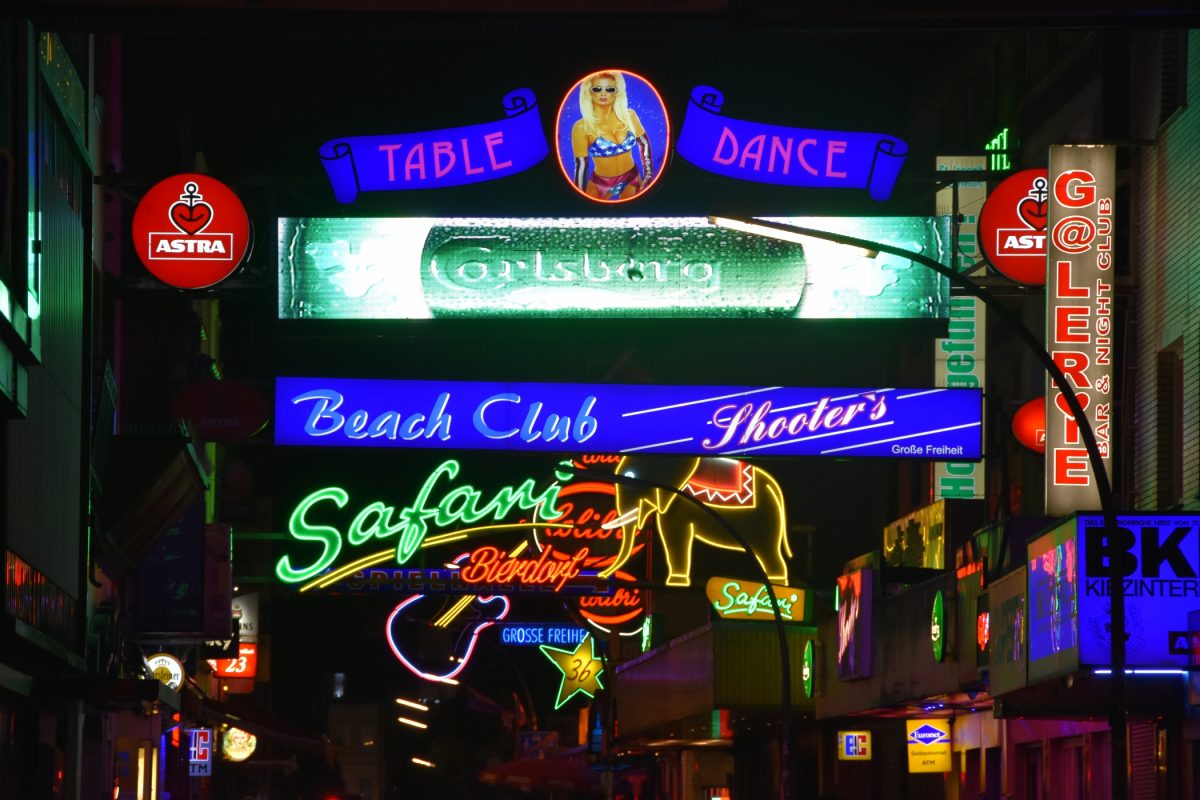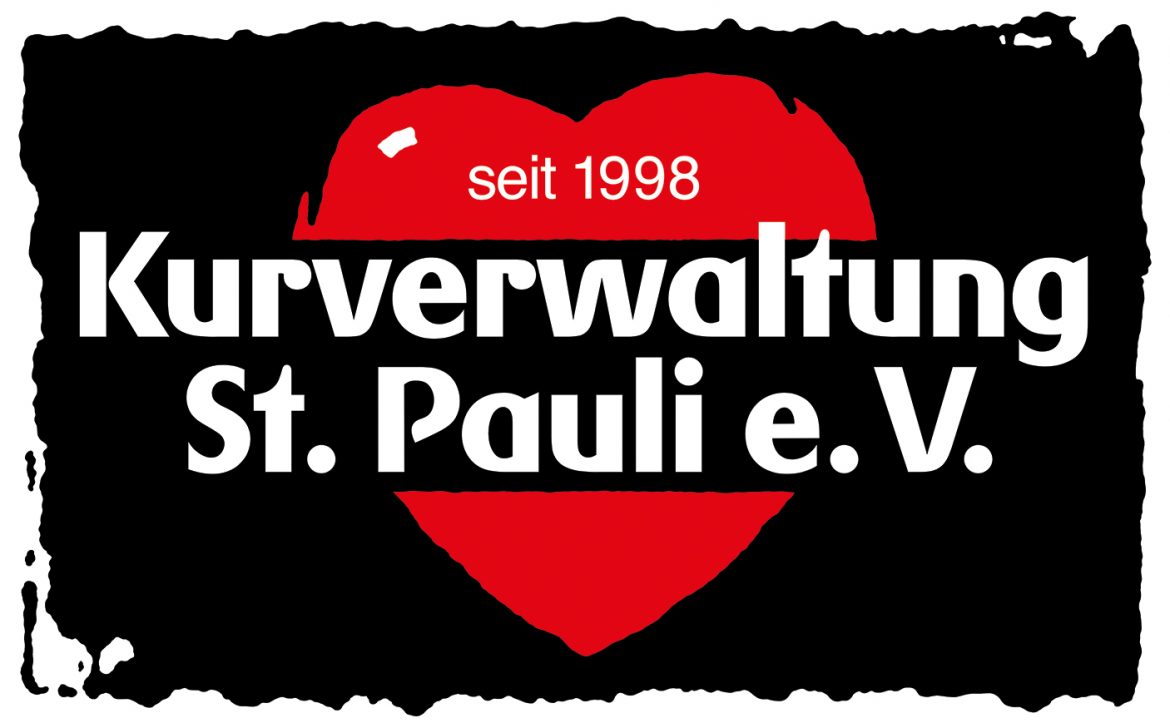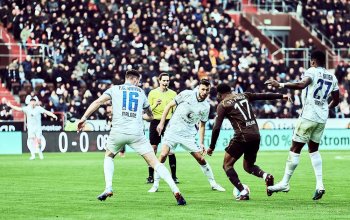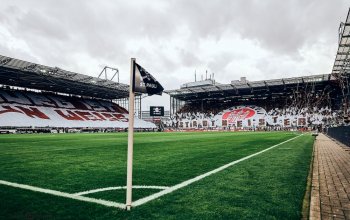Wer mit offenen Augen durchs Viertel geht, wird sie öfter sehen: Touri-Gruppen, die von einem Guide erzählt bekommen, was genau es denn mit diesem berühmten und berüchtigten Stadtteil so auf sich hat. Da gibt es solche und solche – und immerhin auch einen Veranstalter, der das alles zur Unterstützung sozialer Einrichtungen und kultureller Projekte macht, die Kurverwaltung St. Pauli e.V.
Ich traf mich mit Sönke Albertsen und Klaas Eßmüller im Feldstern, die beide im Vorstand des Vereins sitzen, um über die Kurverwaltung zu sprechen. Bevor ich dies tat, begleitete ich Sönke auf der Führung durchs Schanzenviertel, die immer am ersten Samstag im Monat um 15.00h angeboten wird.
Etwa 90 Minuten führte Sönke die kleine Gruppe durch „die Schanze“, startend am Bahnhof, über das ehemalige Schlachterei-Gelände und dann die vielen kleinen Straßen und Hinterhöfe, ehe wir vorm Bunker an der Feldstraße endeten. Und ja, gerade für mich als „Zugezogenen“ waren da furchtbar viele neue Informationen bei.
MillernTon: Sönke, Klaas, vielen Dank für Eure Zeit – erzählt doch zum Einstieg mal, was die Kurverwaltung überhaupt ist, wie und warum sie gegründet wurde.
Klaas: Kurverwaltung St. Pauli e.V. wurde 1998 gegründet. Der konkrete Anlass war die damalige Schließung des Hafenkrankenhauses durch den Senat. Der Stadtteil St. Pauli war finanziell benachteiligt, mit ohnehin schlechter medizinischer Versorgung – und trotzdem war es politischer Wille, diese Schließung durchzuziehen. Dies war 1996 aus Kostengründen beschlossen worden und es regte sich (für den Senat) überraschend viel Protest, u.a. entstand daraus die Bürgerinitiative „Ein Stadtteil steht auf“, mitbegründet von Holger Hanisch, der dann auch die Kurverwaltung und das „CaFée mit Herz“ mit ins Leben rief.
Mit dem wachsenden touristischen Interesse an St. Pauli sollte für den weiterhin sehr armen Stadtteil zumindest irgendwas positiv abfallen, um die sozialen Verhältnisse zu verbessern. Direkt mit Gründung versuchte die Kurverwaltung dies mit der Erhebung einer Kurtaxe an der U-Bahn St. Pauli, wo mit der Klingelbüchse 50 Pfennig gesammelt werden sollten. Der Erfolg war aber übersichtlich und es wurde recht schnell wieder eingestellt.
Was aber dauerhaft daraus entstand, waren die Kiezführungen, die die interessanten Geschichten rund um St.Pauli erzählen, die eben weit über die Lichter der Reeperbahn hinausgehen.
Die Führungen werden von „Kurschatten“ durchgeführt, wir sind allesamt ehrenamtlich unterwegs. Von dem dabei gesammelten Geld werden soziale und kulturelle Initiativen unterstützt.
MT: Aber wie kommt man überhaupt darauf, das dann „Kurverwaltung“ zu nennen? Ich denke da an idyllische Orte wie Bad Salzuflen.
Klaas: Der augenzwinkernde Gedanke dahinter war, dass auch hier alles für einen Kurort vorhanden ist. Das „Heilwasser“ war Astra, welches damals noch auf St.Pauli gebraut wurde. In den zahlreichen Klubs gibt es „Kurkonzerte“, am Hafen die frische Luft – es fehlte also nur die Kurverwaltung.
Sönke: So haben wir den Stadtteil zum Kurort erklärt und liefern auf den Führungen die „Kurschatten“ gleich mit. Es gilt ja auch die Bäderregelung: Geschäfte dürfen am Sonntag geöffnet haben.
MT: Und wie seid Ihr selbst dazu gekommen?
Sönke: Ich bin 1989 vom Dorf nach Hamburg gezogen, habe den Stadtteil und seinen Fußballverein kennen- und lieben gelernt. Und trotzdem kannte auch ich lange Zeit nur die Reeperbahn und fünf-sechs Läden drumherum. 2007 bin ich dann ganz klassisch mitgeschnackt worden, habe mich in das Thema eingearbeitet, mit den Führungen begonnen und es macht unheimlich Spaß.
Klaas: Ich bin 2000 nach Hamburg gezogen und habe damals recht früh als eine der ersten Erkundungsmaßnahmen in dieser Stadt eine der Kiezführungen mitgemacht – und der Kurschatten ging mit uns direkt durch die Hotels! Das wäre heute nicht mehr möglich.
Zur Kurverwaltung bin ich aber erst Anfang 2019 gekommen. Ich musste nach einem Achillessehnenriss mein Hobby Volleyball „an den Nagel hängen“ und habe mir eine neue Aufgabe gesucht – und da diese Führung mich nachhaltig beeindruckt hatte und ich das Thema seitdem immer verfolgt hatte, lag dies dann für mich nahe.

MT: Ihr habt auf Euren Führungen ja ein immenses Detail- und Hintergrundwissen. Wie bereitet Ihr neue Kurschatten auf die Touren vor?
Sönke: Es gibt zwar ein Grundmaterial, welches wir zur Verfügung stellen, aber ansonsten wächst das mit der Zeit und der Erfahrung. Meine ersten Führungen waren Zusammenstellungen aus Führungen, an denen ich selber teilgenommen habe. Mit der Zeit entwickelt man nicht nur seinen eigenen Stil, sondern erlebt und erfährt ja auch ständig neue Dinge. Geschäfte schließen und neue eröffnen, alles verändert sich. Von dem, was ich damals erzählt habe, gehört heute vielleicht noch 20% zu meinen Inhalten, der Rest ist selbst erarbeitet oder erfahren.
Jeder Kurschatten hat sicher auch seine persönliche Note. Bei Klaas und mir kommt der FC St. Pauli eigentlich immer irgendwie vor, bei einem anderen Kollegen fällt der Begriff Fußball vielleicht nie. Genau dies ist auch eine unserer Stärken, denn Gäste melden uns häufig zurück, dass sie zum wiederholten Male teilnehmen und jede Führung doch immer wieder anders ist. Wir versuchen auch immer, die Führungen an die Teilnehmenden anzupassen. Dem Gast der zum ersten Mal in Hamburg ist zeigt man andere Inhalte als gebürtigen Hamburger:innen, die vielleicht eher ein paar unbekannte Ecke entdecken wollen.
MT: Was für Touren gibt es denn überhaupt?
Sönke: Die St.Pauli-Tour ist der Klassiker, die findet an jedem Freitag statt, von März bis Ende November, außer Karfreitag. An jedem ersten Samstag im Monat gibt es die Heimatkunde im Schanzenviertel-Tour. Darüber hinaus gibt es unregelmäßige Touren wie die Tour auf Plattdeutsch oder zu Widerstand und Verfolgung auf St. Pauli, die wir ja auch schon mal in Zusammenarbeit mit dem Fanladen angeboten haben.
Außerdem kann man uns für Firmenevents oder Sportvereine für Teamabende buchen. Auch Fremdsprachen bieten wir auf Anfrage an. Darüber hinaus gibt es auch immer mal wieder kulturelle Veranstaltungen wie Lesungen oder ähnliches.
MT: Was für Schwierigkeiten hat die Pandemie Euch bereitet?
Klaas: Mit den Touren war dann natürlich erst mal Schluss. Mit dem Lockdown hat man gesehen, dass das touristische Leben auf dem Kiez komplett zum Erliegen kam, das betraf uns dann natürlich genauso. Und die gebuchten Touren von Firmen und Vereinen, die fehlten natürlich auch komplett.
Als es jetzt wieder erlaubt war, haben wir ein Hygienekonzept erstellt, welches aktuell 20 Leute pro Tour erlaubt, was auch ausreicht. Die Gäste müssen 1,5m Abstand zueinander halten, der Kurschatten drei Meter – das klappt auch sehr gut.
MT: Schauen wir nochmal auf das Geld, was dabei rum kommt. Wie verteilt Ihr das denn?
Klaas: Wir sind ein eingetragener, gemeinnütziger Verein. Wir bekommen i.d.R. zweckgebundene Spendenanträge von sozialen Gruppen und Initiativen für Projekte auf St. Pauli oder in den angrenzenden Stadtteilen. Über Spendenanträge bis 1.000€ wird auf den monatlichen Treffen der Kurschatten entschieden. Alle größeren Beträge müssen vom Kurdirektorium bewilligt werden – das ist prominent besetzt und vielleicht am ehesten mit einem Aufsichtsrat zu vergleichen.
MT: Könnt Ihr mal ein paar Beispiele dafür nennen, was von Euch gefördert wurde?
Klaas: Die Fördergelder werden jährlich auf unserer Internetseite veröffentlicht. In diesem Jahr gingen die Gelder u.a. an Teestube Sarah, die Krankenstube im ehemaligen Hafenkrankenhaus oder die Bergedorfer Engel. Die Teestube ist ein Projekt welches Tee, Schokolade oder auch Kondome an Prostituierte verteilt. Die Krankenstube unterstützt u.a. Obdachlose und da haben wir einen neuen Fernseher finanziert, weil das für die Obdachlosen dort oft die einzige Informationsquelle zum Weltgeschehen ist.
Sönke: Die Krankenstube hat auch die größte Einzelspende der letzten Jahre erhalten, 3.600€ für drei Krankenbetten – obwohl sie eigentlich nur ein Bett beantragt hatten, wir fanden dies aber so wichtig und unterstützenswert.
Klaas: Die Bergedorfer Engel verteilen auf der Reeperbahn Essen an Obdachlose, da haben wir die Kfz-Steuer für einen Transporter übernommen. Und natürlich gibt es zig weitere Projekte wie das Cafée mit Herz, die Alimaus, Hajusom oder die St.Pauli-Kirche. Da sind sicher „Stammkunden“ dabei, wir sind aber auch immer offen für neue Projekte.

MT: Wie seid Ihr denn personell aufgestellt – braucht Ihr noch neue „Kurschatten“?
Sönke: Unbedingt! Wir sind aktuell etwa zehn Personen, die die Führungen anbieten. Da haben uns in der Pandemie auch ein paar verlassen, wir könnten also schon Nachwuchs gebrauchen und es wäre natürlich super, wenn sich unter den MillernTon-Leser:innen jemand finden würde.
MT: Und was sollten die mitbringen?
Klaas: Dafür sollte man in erster Linie Bock haben, Menschen über den Kiez zu führen und hinter die Kulissen blicken zu lassen. Es hilft, wenn man Spaß am Reden hat, offen für andere Menschen ist und eine Affinität zu St. Pauli und den angrenzenden Stadtteilen hat und auch ein Interesse daran, sich da hineinzulesen.
Und dann braucht es natürlich Zeit. Eine gebuchte Tour dauert zwar „nur“ etwa zwei Stunden, aber das braucht auch Vor- und Nachbereitung. Im Schnitt, mit den buchbaren Touren, kommt man da so im Schnitt auf eine Tour pro Monat pro Person.
Wer sich das grundsätzlich vorstellen kann, soll sich einfach mal bei uns melden oder auf ne Tour mitkommen und vielleicht mal zum nächsten Kurschatten-Treffen kommen, Termin und Ort teilen wir dann mit.
MT: Wie seht Ihr denn die anderen Gruppen und Touren, die über den Kiez ziehen?
Klaas: Wir sind der einzige Anbieter, der die Touren ohne kommerziellen Hintergrund anbietet. Leider sind wir u.a. dadurch auch medial nicht so präsent wie Andere. Aber dafür versuchen wir es zu vermeiden, vom „1. FC St. Pauli“ zu sprechen – wie kürzlich von weitem gehört…
Sönke: Es gibt sicher gute Mitbewerber, mit denen man ein kollegiales Verhältnis hat und die man unterwegs auch freundlich grüßt, beispielsweise Hempels Beatles Tour mit ihrer Ukulele. Es gibt aber auch bei der Masse dann viele andere, vorsichtig formuliert. Wir haben ja auch einen kulturellen Anspruch und da würde es nicht passen, wenn wir alle 90 Sekunden auf Krampf ’nen Schenkelklopfer präsentieren. Wir machen das sicher auch unterhaltsam und auch mal lustig, aber wer da volltrunken im Rahmen des Junggesellenabschieds eine Tour machen möchte – nun ja, für den gibt es „passendere“ Veranstalter als uns.
MT: Letzte Frage: Was könnt Ihr unseren Leser:innen denn hier jetzt mal verraten, was sie bisher vielleicht noch nicht über St. Pauli wussten? Es darf natürlich auch nur weitergelesen werden, wenn man sich vorher vertraglich verpflichtet demnächst eine Eurer Touren zu besuchen, wenn man das dann wirklich noch nicht wusste.
Sönke: Die St. Pauli-Kirche wurde nach der Besetzung durch die napoleonischen Truppen (1813-14) im Jahr 1820 neu erbaut. Das Geld war aber damals knapp, so dass als Baumaterial Gegenstände verwendet wurden, die zuvor eine andere Nutzung erfahren haben. Die Bretter des Bodens der Kirche waren ausgediente Schiffsplanken, die im Hafen angefallen sind. Sie haben somit früher die ganze Welt gesehen. Die Kirche ist übrigens eine sehr lebendige Kirche. 2013 verbrachten 80 afrikanische Flüchtlinge dort ein halbes Jahr im Kirchenasyl. Während des Reeperbahnfestivals finden auch Konzerte in der Kirche statt.
Klaas: Oder aus einem komplett anderen Bereich: Es gab auf St. Pauli nicht nur eine Helgoländer Allee sondern auch eine Sylter Allee – fast parallel dazu. Die Straße wurde dann zugeschüttet und mit einem Bunker bebaut – einem von handgezählten sechs Bunkern auf St. Pauli.
MT: Vielen Dank für Eure Zeit und alles Gute für Euch und die Kurverwaltung!
// Maik
Alle Beiträge beim MillernTon sind gratis. Wir freuen uns aber sehr, wenn Du uns unterstützt.
MillernTon auf BlueSky // Mastodon // Facebook // Instagram // Threads // WhatsApp // YouTube
{:}{:en}If you walk through the district with your eyes open, you will see them more often: Groups of tourists who are told by a guide what exactly this famous and notorious district is all about. There are such and such – and at least one organiser who does all this to support social institutions and cultural projects, the Kurverwaltung St. Pauli e.V.
I met with Sönke Albertsen and Klaas Eßmüller at the Feldstern, who are both on the board of the association, to talk about the Kurverwaltung. Before doing so, I accompanied Sönke on the guided tour of the Schanzenviertel, which is always offered on the first Saturday of the month at 15:00h.
For about 90 minutes, Sönke led the small group through „die Schanze“, starting at the station, across the former butcher’s premises and then the many small streets and backyards before we ended in front of the bunker on Feldstraße. And yes, especially for me as someone who once relocated to Hamburg there was an awful lot of new information.
MillernTon: Sönke, Klaas, thank you very much for your time – why don’t you start by telling us what the Kurverwaltung is all about, how and why it was founded.
Klaas: Kurverwaltung St. Pauli e.V. was founded in 1998. The specific occasion was the closure of the harbour hospital by the Senate at that time. The St. Pauli district was financially disadvantaged, with poor medical care anyway – and yet it was political will to go through with this closure. This was decided in 1996 for cost reasons and surprisingly (for the senate) a lot of protests arose, including the citizens‘ initiative „Ein Stadtteil steht auf“ (A district stands up), co-founded by Holger Hanisch, who then also co-founded the Kurverwaltung and the „CaFée mit Herz“.
With the growing tourist interest in St. Pauli, there should at least be something positive for the still very poor district to improve social conditions. Right from the start, the spa administration tried to do this by levying a visitor’s tax at the St. Pauli underground station, where 50 pfennigs were to be collected with the bell box. However, it was not very successful and was soon discontinued.
What did emerge permanently, however, were the Kiezführungen (guided tours of the neighbourhood), which tell interesting stories about St.Pauli that go far beyond the lights of the Reeperbahn.
The tours are conducted by „Kurschatten“, we are all volunteers. The money raised supports social and cultural initiatives.
MT: But how do you come up with the idea of calling it a “Kurverwaltung” (which would translate to something like „spa administration“)? I think of idyllic places like Bad Salzuflen.
Klaas: The tongue-in-cheek idea behind it was that everything for a health resort is also available here. The „healing water“ was Astra, which was still brewed on St.Pauli at that time. There are „spa concerts“ in the numerous clubs, the fresh air at the harbour – so the only thing missing was the spa administration.
Sönke: We have declared the district a health resort and provide the „Kurschatten“ (which would translate to spa shadows, usually a fling one has while on a spa vacation which is considered a shadow as it follows the one on a spa vacation 24/7) on the guided tours. The spa regulations also apply: shops are allowed to be open on Sundays.
MT: And how did you come to it yourselves?
Sönke: I moved from the village to Hamburg in 1989, got to know and love the district and its football club. And yet, for a long time, I only knew the Reeperbahn and five or six shops around it. Then, in 2007, I got involved in the classic way, familiarised myself with the subject, started with the guided tours and it’s a lot of fun.
Klaas: I moved to Hamburg in 2000 and at that time I took one of the Kiez tours quite early as one of the first explorations in this city – and the Kurschatten walked with us right through the hotels! That would no longer be possible today.
However, I only came to the Kurverwaltung at the beginning of 2019. After rupturing my Achilles tendon, I had to give up my volleyball hobby and was looking for a new job – and since this tour had made a lasting impression on me and I had always followed the topic since then, this was the obvious choice for me.

MT: You have an immense amount of detailed and background knowledge on your tours. How do you prepare new Kurschatten for the tours?
Sönke: There is a basic material that we provide, but otherwise it grows with time and experience. My first tours were compilations of tours I had taken myself. Over time, you not only develop your own style but you also experience and learn new things all the time. Shops close and new ones open, everything changes. Of what I told back then, perhaps 20% is still part of my content today, the rest has been worked out or experienced by myself.
Every Kurschatten certainly has his or her own personal touch. With Klaas and me, FC St. Pauli always comes up somehow, with another colleague the term football may never come up. This is precisely one of our strengths because guests often report back to us that they are taking part again and again, and yet each tour is always different. We also always try to adapt the tours to the participants. Guests who are in Hamburg for the first time are shown different content than native Hamburgers who perhaps want to discover a few unknown corners.
MT: What kind of tours are there anyway?
Sönke: The St.Pauli tour is the classic, it takes place every Friday, from March to the end of November, except Good Friday. On the first Saturday of every month, there is the Heimatkunde im Schanzenviertel tour. In addition, there are irregular tours such as the tour in Low German or on resistance and persecution in St. Pauli, which we have already offered in cooperation with the fan shop.
You can also book us for corporate events or sports clubs for team evenings. We also offer foreign languages on request. In addition, there are also cultural events such as readings and the like from time to time.
MT: What kind of difficulties did the pandemic cause you?
Klaas: Of course, the tours came to an end for the time being. With the lockdown, we saw that the tourist life on the Kiez came to a complete standstill, which of course affected us just as much. And the tours booked by companies and associations were of course also completely absent.
When it was allowed again, we created a hygiene concept that currently allows 20 people per tour, which is sufficient. The guests have to keep a distance of 1.5 metres from each other, the Kurschatten three metres – and that works very well.
MT: Let’s take another look at the money that comes in. How do you distribute it?
Klaas: We are a registered non-profit association. We usually receive earmarked donation requests from social groups and initiatives for projects on St. Pauli or in the neighbouring districts. Requests for donations of up to €1,000 are decided on at the monthly meetings of the Kurschatten. All larger amounts have to be approved by the associations‘ director’s board- which has a prominent member and can perhaps best be compared to a supervisory board.
MT: Can you give a few examples of what you have promoted?
Klaas: The funding is published annually on our website. This year, the money went to the Teestube Sarah, the infirmary in the former harbour hospital and the Bergedorfer Engel, among others. The Teestube is a project that distributes tea, chocolate and condoms to prostitutes. The „Krankenstube“ supports homeless people and we financed a new television because for the homeless there it is often the only source of information about world events.
Sönke: The infirmary also received the largest single donation in recent years, 3,600€ for three infirmary beds – although they had actually only applied for one bed, we found this so important and worthy of support.
Klaas: The Bergedorf Engel distribute food to the homeless on the Reeperbahn; we paid the vehicle tax for a van. And of course, there are many other projects like the Cafée mit Herz, the Alimaus, Hajusom or the St. Pauli Church. There are certainly „regular customers“, but we are always open to new projects.

MT: How are you positioned in terms of personnel – do you still need new „Kurschatten“?
Sönke: Absolutely! We are currently about ten people who offer the tours. Some of them left us during the pandemic, so we could use some new blood, and it would of course be great if we could find someone among the MillernTon readers.
MT: And what should they bring with them?
Klaas: First and foremost, you should want to take people on a tour of the neighbourhood and let them look behind the scenes. It helps if you enjoy talking, are open to other people and have an affinity for St. Pauli and the neighbouring districts and also have an interest in reading upon them.
And then, of course, it takes time. A booked tour „only“ lasts about two hours, but that also needs preparation and follow-up. On average, with bookable tours, you end up with one tour per month per person.
If you can imagine doing this, just get in touch with us or come along on a tour and maybe come to the next Kurschatten meeting, we will let you know the date and place.
MT: What do you think of the other groups and tours that move through the neighbourhood?
Klaas: We are the only provider who offers tours without a commercial background. Unfortunately, this is one of the reasons why we are not as present in the media as others. But we try to avoid talking about the „1st FC St. Pauli“ – as recently heard from far away…
Sönke: There are certainly good competitors with whom you have a collegial relationship and whom you also greet in a friendly manner on the road, for example, Hempel’s Beatles Tour with their ukulele. But there are also many others in the masses, to put it cautiously. We also have a cultural claim, and it wouldn’t fit in if we were to present a knee-slapper every 90 seconds. We certainly do it entertainingly and sometimes funny, but if you want to do a tour drunk as a bachelor party – well, there are more „suitable“ organisers than us.
MT: Last question: What can you tell our readers here that they might not have known about St. Pauli yet? Of course, you can only read on if you make a contractual commitment to visit one of your tours in the near future if you really didn’t know that yet.
Sönke: St. Paul’s Church was rebuilt after the occupation by Napoleonic troops (1813-14) in 1820. Money was scarce at the time, however, so items that had previously had a different use were used as building materials. The planks of the floor of the church were discarded ship planks that had accumulated in the harbour. Thus, they used to see the whole world. Incidentally, the church is a very lively church. In 2013, 80 African refugees spent half a year there in church asylum. Concerts are also held in the church during the Reeperbahn Festival.
Klaas: Or from a completely different area: There was not only a Helgoländer Allee on St. Pauli but also a Sylter Allee – almost parallel to it. The street was then filled in and built on with a bunker – one of hand-counted six bunkers on St. Pauli.
MT: Thank you very much for your time and all the best for you and the Kurverwaltung!
//Maik (translation by Arne)
MillernTon Twitter //
MillernTon YouTube //
MillernTon Facebook //MillernTon Instagram //
If you like what we do here, here you’ll find the information on how to support us.
{:}




Schön, dass hier neben Fußball Platz für solche Sachen ist. Danke. 👍
Sechs Bunker auf St. Pauli?! Ich kenne einen Bunker auf dem Heiligengeistfeld, einen Bunker an der Schomburgstraße, Ecke Unzerstraße (Kebap – Kulturenergiebunker) (wobei das wohl schon Altona ist?), einen Bunker in der Otzenstraße auf Höhe der Bernstorffstr. (wobei, auch der ist bereits in Altona)…
Hm. Hast du dir verraten lassen, wo diese 6 Bunker sind?